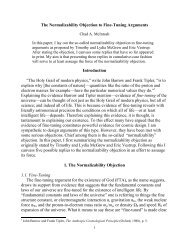Theism and Explanation - Appeared-to-Blogly
Theism and Explanation - Appeared-to-Blogly
Theism and Explanation - Appeared-to-Blogly
You also want an ePaper? Increase the reach of your titles
YUMPU automatically turns print PDFs into web optimized ePapers that Google loves.
Potential Theistic <strong>Explanation</strong>s 81<br />
abilities of human designers. 7 Perhaps we could identify the designed products<br />
even of extraterrestrial intelligent beings, on the assumption that they<br />
are the products of an evolutionary process similar <strong>to</strong> that which produced<br />
us. The problem is that the less similarity there is between a purported<br />
designer <strong>and</strong> ourselves, the less confi dent we can be in specifying how he<br />
might be expected <strong>to</strong> act. When it comes <strong>to</strong> God, who of all designers<br />
surely resembles us the least, we are entirely in the dark. This inability <strong>to</strong><br />
specify how a putative designer might be expected <strong>to</strong> act is, Sober argues,<br />
“the Achilles’ heel of the design argument.” 8 Is there a way of avoiding<br />
this sceptical conclusion? Well, Sober notes, the theist may be tempted <strong>to</strong><br />
argue that we do know what God intended. We can discover his intention<br />
by inspecting the products of his design, namely what we see around us. 9<br />
But of course this merely begs the question, which is whether what we see<br />
around us is the product of divine design. Or theists might argue that<br />
if the existence of the vertebrate eye is what one wishes <strong>to</strong> explain,<br />
their hypothesis is that the intelligent designer constructed the vertebrate<br />
eye. If it is the characteris tics of the vertebrate eye (the fact<br />
that it has features F 1 , F 2 , . . . F n ), rather than its mere existence, that<br />
one wants <strong>to</strong> explain their hypothesis is that an intelligent designer<br />
constructed the vertebrate eye with the intention that it have features<br />
F 1 , F 2 , . . . F n <strong>and</strong> that this designer had the ability <strong>to</strong> bring his plans<br />
<strong>to</strong> fruition. 10<br />
But this reasoning is empty, since it would enable the proposition God created<br />
it <strong>to</strong> “explain” anything at all. More precisely, such reasoning merely<br />
builds in<strong>to</strong> the theistic hypothesis “the observations we seek <strong>to</strong> explain.” 11<br />
For this reason, I would add, it would be another case of what Philip Kitcher<br />
calls “spurious unifi cation” (3.2.3.1). 12<br />
Sober’s view seems <strong>to</strong> be that this is a kind of in principle objection.<br />
However, I have already described it as a de fac<strong>to</strong> one (2.2.1). The following<br />
argument does constitute a potential explanation of E.<br />
(1) God wills E.<br />
(2) Whatever God wills comes <strong>to</strong> pass.<br />
(3) Therefore E.<br />
For it does correspond <strong>to</strong> the second premise of Peirce’s schema (2.1.2). The<br />
problem is that it does so in an almost trivial fashion, which is little more<br />
than a restatement of E. And it is a potential explanation we have good<br />
reason not <strong>to</strong> accept, since it would be untestable (7.1). Sober does concede<br />
that the theist could keep postulating divine goal-ability pairs until she<br />
fi nds one which does explain the world as we see it. But, he argues, one<br />
cannot simply invent such auxiliary hypotheses at will. They need <strong>to</strong> be<br />
independently testable <strong>and</strong>, ideally, <strong>to</strong> have passed independent tests. 13



